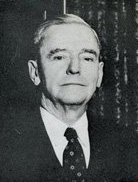John Shepard Wright-Benefactor of Forestry in Indiana*
by W.C. Bramble

John Shepard Wright was a quiet, scholarly man recognized for his wisdom and integrity. Thus reads an excerpt from an announcement of his passing in the Proceedings of the Indiana Academy of Science for 1951. John S. Wright’s interest in science and forestry throughout a long and successful career (from 1892 to 1951) with the Eli Lilly Company as a scientist and business executive makes an interesting and important story in relation to forestry in Indiana. While John S. Wright was highly regarded by scientists for his long and outstanding service to the Indiana Academy, he was also an associate and friend of the forestry leaders in the state.
One first encounters the forestry interests of the young Purdue graduate of 1892 in the pages of the Proceedings of the Indiana Academy in 1892 (1) when he published, “Notes on Certain Plants of Southwestern Indiana,” reporting on a study he had made with D. T. MacDougal on forests in the “pocket” region of Indiana. Special notes were taken of the distribution, size, and other features of certain forest trees: Celtis mississippiensis, Carya olivaeformis, Quercus lyrata, Diospyros virginiana, and Taxodium distichum.
In later issues of the Proceeding, John S. Wright published short articles on woody plants and forests. “Notes on Sectioning Woody Tissues” was published in 1893 (2) and “Inarching of Oak Trees” in 1897 (3). Also in 1897, he published “Notes on the Cypress Swamps of Knox County” (4). In the last account, a description is given of the disappearance of cypress over an 18-20 square mile area as the result of cutting. Cypress trees 111 to 130 feet tall and 3½ feet in diameter at 4 feet above ground were reported. In 1902, he published an account of the occurrence of an abnormality in the nut of Hicoria ovata (5) as an interesting deviation from type in a species not known to hybridize freely.
While these publications of the young scientist indicate an early interest in trees and forests, perhaps his greatest interest was engendered through contacts with the other leading Indiana scientists of the early 1900’s, most of whom were his friends and fellow workers in the Indiana Academy. John S. Wright was Secretary of that organization from 1894 to 1904 and a member of the Executive Committee from 1896 to 1951. In 1904-5, he was President of the Academy. The John Shepard Wright Memorial Library of the Indiana Academy of Science is testimony to the esteem in which he was held. In 1940 Purdue conferred the honorary LL.D. degree on John Wright in recognition of his outstanding career.
Important to forestry were the contacts and friendships of John S. Wright with the founders of forestry in Indiana: Dr. Stanley Coulter, the Dean of the School of Science, who taught and established forestry in 1914 at Purdue; Charles C. Deam, the first State Forester of Indiana, and considered to be the father of state forestry in Indiana; Prof. Daniel DenUyl, who was a leading teacher and researcher in forestry at Purdue. All these men, and others, were in the scientific group that developed forestry in the state and were active in the Academy with John Wright.
In 1964, announcement was made of the establishment of the “John S. Wright Fund for the Promotion of Forestry in Indiana” to be expended under the direction of the Trustees of Purdue University. The Fund was made possible through the will of John Shepard Wright, whose generous gift will undoubtedly prove to be the greatest single impetus given to forestry in the state since education in forestry was established in 1914. By wise use of the fund, much that hitherto seemed impossible should be accomplished, and it appears inevitable that John S. Wright will come to be recognized as the greatest individual benefactor of forestry in Indiana.
* Forestry and Conservation in Indiana, William C. Bramble, Ed., 1965, Purdue University Department of Forestry and Conservation
Publications:
- Wright, John S. Notes on certain plants of southwestern Indiana. Proceedings of the Indiana Academy of Science, p.41. 1982.
- Wright, John S. Notes on sectioning woody tissues. Proceedings of the Indiana Academy of Science. p.234. 1983.
- Wright, John S. Inarching of oak trees. Proceedings of the Indiana Academy of Science. p. 171-172. 1897.
- Wright, John S. Notes on the cypress swamps of Knox County. Proceedings of the Indiana Academy of Science. p. 172-175 1897.
- Wright, John S. An abnormality in the nut of Hicoria ovata (Mill) Briton. Proceedings of the Indiana Academy of Science. p. 165.1902.
Lab Manager & More About Our Research
Bob Rode
Purdue ASREC
Aquaculture Research Lab
5675 W 600 N
W. Lafayette IN 47906
Phone: 765-418-5509
Email:rrode@purdue.edu
Learn about our nine Research Areas and meet our world-class faculty members.
Allied research centers seek to support and enhance the research and partnership enterprise at Purdue University. The centers are valued and encouraged as they create a venue for faculty to come together to pursue common goals. Forestry and Natural Resources faculty and staff are involved in six centers at the University.
The Department of Forestry and Natural Resources maintains an impressive collection of state-of-the-art research and education facilities. These labs, green houses, and educational facilities are a fundamental component that enables our faculty and students to learn, make new discoveries, and engage our clients in using these discoveries to sustain our nation’s ecosystems and natural resources.
